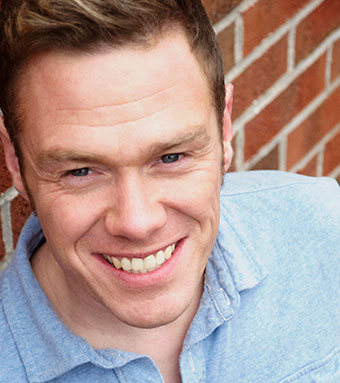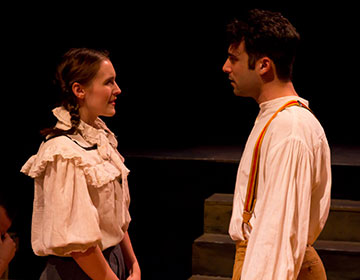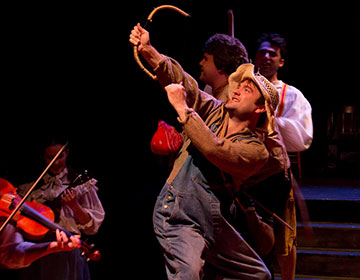Next story: Buffalo to Big Apple Circus
The Twain Shall Meet
by Anthony Chase

Director Chris Kelly on Tom Sawyer
Chris Kelly is a fixture in the theater community. He’s worked as an actor and as a director. In the latter role he’s made a reputation for re-envisioning classics with invention and a minimalist aesthetic. He is also the manager for the popular local music group, The Albrights. He cast two of the group members as Tom Sawyer and Huckleberry Finn at the New Phoenix Theatre. Here he answers some questions about staging one of the most loved stories in American literature.
What attracted you to the story of Tom Sawyer?
Simply, it’s a rollicking adventure with humor, heart, actual stakes and tough choices. We have mystery, pirates, buried treasure and first love but also glean a lot about what it means to move from boyhood to manhood. Oh, and it’s Mark Twain! His characters are simultaneously vividly drawn and real. The writing is beautiful.
How would you characterize your vision as a director and what are your primary influences?
As a director I’m really compelled to create theater that is minimalistic and engages an audience’s imagination. While I can appreciate it if you make it actually rain on stage, I’d rather engage the audience as an extension of the ensemble, make them feel like it was raining through physicality, a live soundscape, music etc. I love when they see behind the proverbial curtain and then forget it’s there. Working with Javier [Bustillos] and BUA has had an enormous impact on all that I do. I used to hear many people say to Javier “Wow, if you had more money just think of the sets you could build!” To which he replied, “I’d just get nicer blocks!” That is what he instilled in me. Theater is about the relationship between the actors, the energy being created in the space. Everything else is secondary, and possibly, a distraction. Kelli Bocock Natale, and more recently, Megan Callahan’s work as directors and friends are true influences. We share a similar aesthetic. Pointedly, though, for Tom Sawyer, three things were important influences: Our Town (it was the first play I was ever in so it’s always there somehow), Little House On The Prairie and Emmet Otter’s Jugband Christmas. I wanted it to feel like one of the warm holiday specials I watched growing up.
What were the greatest challenges of staging this story?


Ha, well I think I created some of the challenges in staging the show with live music thus creating the need for a whole other series of rehearsals and extensive preparation! I’m pretty used to doing shows where actors play multiple roles but think it has to be done very mindfully and with great, clear specificity. Lastly, young adults playing kids is always tricky so we had to remain mindful throughout to play the scenes as honestly as possible without trying to ‘play young.’
Why did you decide to go with musicians, rather than actors for the two leads? Was this a risk?
Well, at this point Brandon Barry and Joe Donohue (as well as The Albrights’ bassist Matt Crane) have not only done plays and musicals with me, but without me as well. So I think we can now call them musicians as well as actors. However, I know what you mean of course. Casting two people who are much greener than others their age in town is a gamble. I think that being green, in tandem with who they are as people, is what makes them so perfect for this piece. Of course, they are friends and bandmates offstage which is chemistry you simply can’t manufacture but also what they project as people: a heart-on-your-sleeve emotionality, a truthful enthusiasm , a rascally sense of mischief and ultimately an authentic boyishness that encapsulate Tom and Huck. Additionally, it’s wonderful we live somewhere where artists can grow and learn while preforming in shows. I have no biological younger siblings of my own so while it’s gratifying to collaborate with them I’m also just really damn proud of how far they have come.
Mark Twain wrote during an especially turbulent period for race relations in America. In Adventures of Huckleberry Finn (1885) and Pudd’nhead Wilson (1894) he champions rights for African Americans, but in The Adventures of Tom Sawyer, “Injun Joe” is a monster. How did you walk this line?
Well, I think the closer I looked at both the book and the script, Injun Joe does terrible things, evil things but Twain and Eason do give us the reasons for why he does so. He has lines about his people living on this land with ‘peace and plenty’ and it being taken. Without condoning murder, the author still shows Injun Joe has been treated horribly by this town. I walked the line by working with the fabulous Anthony Alcocer who plays the role on how to nuance the character. His initial instinct was to play those moments full out, letting out that rage. What we discovered was if we let him get quiet, let his facade fall, we saw the character’s pain.
You used to be known primarily as an actor, but now you are seen primarily as a director. What fueled this shift?
Honestly, I still love both. I think I really need to do both, to constantly keep mixing it up back and forth to remain somewhat sane and well rounded. However, I’ve always greatly envied painters, photographers and recording artists. They can always look at what they create be it next week or ten years from now. With acting, you are immersed in it, there is no stepping back and enjoying what you’ve created. Directing is as close as I can get to being a painter, to create something lasting. When I direct, I humbly look at the plays as my temporary paintings and I love nothing more than to watch an audience watch them, that shared experience. The beauty and madness of it all is that they teach you to be in the present and soak it all in and, sadly, about letting go.
Tom Sawyer plays at the New Phoenix Theatre through this weekend.
|
Issue Navigation> Issue Index > v13n51 (Week of Thursday, December 18) > The Twain Shall Meet This Week's Issue • Artvoice Daily • Artvoice TV • Events Calendar • Classifieds |









 Current Issue
Current Issue